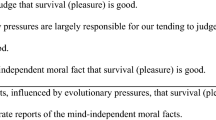Abstract
In this paper, I provide a general introduction to the trolley problem. I describe its birth as a philosophical thought experiment, then its successful career in moral psychology. I explain the different reasons behind its popularity and success but argue that, despite its popularity and widespread utilization in psychological research, few researchers have actually tried to directly solve it and that we are still ignorant of the real factors guiding our responses to trolley cases. Against the idea that trolley problems were just a fad, I insist on the importance of seriously studying them and put forward a new hypothesis about the psychological mechanisms underlying our responses to trolley cases.






Similar content being viewed by others
Notes
Actually, in a footnote of his book, Unger tells us that he sought the help of his colleagues from the Psychology Department to put his hypothesis to the test. Unfortunately, he didn’t have much success. The times were not ripe for the empirical study of moral intuitions.
References
Ahlenius, H., & Tännsjö, T. (2012). Chinese and Westerners respond differently to the trolley dilemmas. Journal of Cognition and Culture, 12(3–4), 195–201.
Bartels, D. M., & Pizarro, D. A. (2011). The mismeasure of morals: Antisocial personality traits predict utilitarian responses to moral dilemmas. Cognition, 121(1), 154–161.
Cushman, F., & Greene, J. D. (2012). Finding faults: How moral dilemmas illuminate cognitive structure. Social Neuroscience, 7(3), 269–279.
Cushman, F., Young, L., & Hauser, M. (2006). The role of conscious reasoning and intuition in moral judgment: Testing three principles of harm. Psychological Science, 17(12), 1082–1089.
Duke, A. A., & Bègue, L. (2015). The drunk utilitarian: Blood alcohol concentration predicts utilitarian responses in moral dilemmas. Cognition, 134, 121–127.
Dupoux, E., & Jacob, P. (2007). Universal moral grammar: A critical appraisal. Trends in Cognitive Sciences, 11(9), 373–378.
Feltz, A., & May, J. (2017). The means/side-effect distinction in moral cognition: A meta-analysis. Cognition, 166, 314–327.
Foot, P. (1967). The problem of abortion and the doctrine of double effect. Oxford Review, 5, 5–15.
Greene, J. (2009). Fruit flies of the moral mind. In M. Brockman (Ed.), What’s next? Dispatches on the future of science (pp. 104–115). Toronto: Random House of Canada.
Greene, J. D. (2014). Beyond point-and-shoot morality: Why cognitive (neuro) science matters for ethics. Ethics, 124(4), 695–726.
Greene, J. D., Cushman, F. A., Stewart, L. E., Lowenberg, K., Nystrom, L. E., & Cohen, J. D. (2009). Pushing moral buttons: The interaction between personal force and intention in moral judgment. Cognition, 111(3), 364–371.
Greene, J. D., Sommerville, R. B., Nystrom, L. E., Darley, J. M., & Cohen, J. D. (2001). An fMRI investigation of emotional engagement in moral judgment. Science, 293(5537), 2105–2108.
Haidt, J. (2001). The emotional dog and its rational tail: A social intuitionist approach to moral judgment. Psychological Review, 108(4), 814–834.
Hauser, M. (2006). Moral minds: How nature designed our universal sense of right and wrong. New York: Ecco/HarperCollins Publishers.
Hauser, M., Cushman, F., Young, L., KangXing Jin, R., & Mikhail, J. (2007). A dissociation between moral judgments and justifications. Mind and Language, 22(1), 1–21.
Killgore, W. D., Killgore, D. B., Day, L. M., Li, C., Kamimori, G. H., & Balkin, T. J. (2007). The effects of 53 hours of sleep deprivation on moral judgment. Sleep, 30(3), 345–352.
Koenigs, M., Young, L., Adolphs, R., Tranel, D., Cushman, F., Hauser, M., et al. (2007). Damage to the prefrontal cortex increases utilitarian moral judgements. Nature, 446(7138), 908–911.
Kohlberg, L. (1963). The development of children’s orientations toward a moral order. Human Development, 6(1–2), 11–33.
Kohlberg, L., & Hersh, R. H. (1977). Moral development: A review of the theory. Theory into Practice, 16(2), 53–59.
McIntyre, A. (2014). Doctrine of double effect. In: E. N. Zalta (ed.), Stanford Encyclopedia of Philosophy (Winter 2014). Stanford: Metaphysics Research Lab, Stanford University.
Michelin, C., Pellizzoni, S., Tallandini, M. A., & Siegal, M. (2010). Should more be saved? Diversity in utilitarian moral judgment. Journal of Cognition and Culture, 10(1), 153–169.
Mikhail, J. (2007). Universal moral grammar: Theory, evidence and the future. Trends in Cognitive Sciences, 11(4), 143–152.
Mikhail, J. (2011). Elements of moral cognition: Rawls’ linguistic analogy and the cognitive science of moral and legal judgment. Cambridge: Cambridge University Press.
Nadelhoffer, T., & Feltz, A. (2008). The actor–observer bias and moral intuitions: Adding fuel to Sinnott-Armstrong’s fire. Neuroethics, 1(2), 133–144.
Nisbett, R. E., & Wilson, T. D. (1977). Telling more than we can know: Verbal reports on mental processes. Psychological Review, 84(3), 231–259.
Pellizzoni, S., Siegal, M., & Surian, L. (2010). The contact principle and utilitarian moral judgments in young children. Developmental Science, 13(2), 265–270.
Petrinovich, L., & O’Neill, P. (1996). Influence of wording and framing effects on moral intuitions. Ethology and Sociobiology, 17(3), 145–171.
Petrinovich, L., O’neill, P., & Jorgensen, M. (1993). An empirical study of moral intuitions: Toward an evolutionary ethics. Journal of Personality and Social Psychology, 64(3), 467.
Royzman, E. B., Kim, K., & Leeman, R. F. (2015). The curious tale of Julie and Mark: Unraveling the moral dumbfounding effect. Judgment and Decision Making, 10(4), 296.
Spranca, M., Minsk, E., & Baron, J. (1991). Omission and commission in judgment and choice. Journal of Experimental Social Psychology, 27(1), 76–105.
Suter, R. S., & Hertwig, R. (2011). Time and moral judgment. Cognition, 119(3), 454–458.
Thomson, J. J. (1976). Killing, letting die, and the trolley problem. The Monist, 59(2), 204–217.
Thomson, J. J. (1985). The trolley problem. The Yale Law Journal, 94(6), 1395–1415.
Turiel, E. (1983). The development of social knowledge: Morality and convention. Cambridge: Cambridge University Press.
Unger, P. K. (1996). Living high and letting die: Our illusion of innocence. USA: Oxford University Press.
Waldmann, M. R., & Dieterich, J. H. (2007). Throwing a bomb on a person versus throwing a person on a bomb: Intervention myopia in moral intuitions. Psychological Science, 18(3), 247–253.
Author information
Authors and Affiliations
Corresponding author
Rights and permissions
About this article
Cite this article
Cova, F. What Happened to the Trolley Problem?. J. Indian Counc. Philos. Res. 34, 543–564 (2017). https://doi.org/10.1007/s40961-017-0114-x
Received:
Revised:
Accepted:
Published:
Issue Date:
DOI: https://doi.org/10.1007/s40961-017-0114-x




